#living history reenactment
Text
Some lifehacks
#history#museam#museum#history museum#living history#museum work#historical interpreter#living history museum#historical reenactment#historian#historical costuming#living history reenactment#sca#the society of creative anachronism#mysca
52 notes
·
View notes
Text


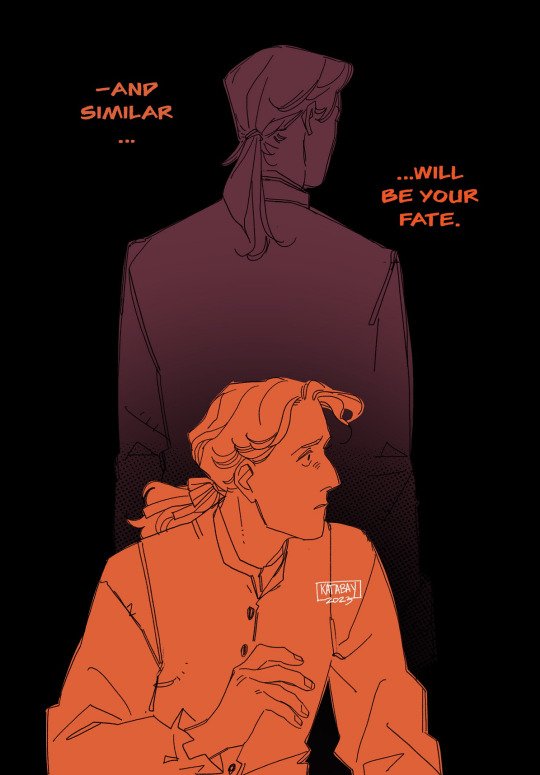
A SPY FOR A SPY
an informal AmRev sketch dump type of thing circling around some thoughts: Benjamin Tallmadge and the corpse of Nathan Hale (they never did recover Hale's corpse, so this is like. you know. symbolism. it's why Tallmadge isn't looking directly at the body, but oh something in you has changed. loss defines the outline, the shape. that body is going to be inside you forever), bad dreams with John Andre and something that looks like Nathan Hale, and the finally Tallmadge and Andre. they turned your friend into a martyr, Tallmadge, but before that, he was your friend, and that makes this personal.
there's a. triangle. happening between these three. a kind of ritual substitution. the absence of Hale's body demands a body in it's place, John Andre's fate was sealed the minute Nathan Hale died.
also, in the first one, Hale's feet are bound because that's my favorite awful detail from both the MacMonnies statue and the Pratt statue.

(MacMonnies)
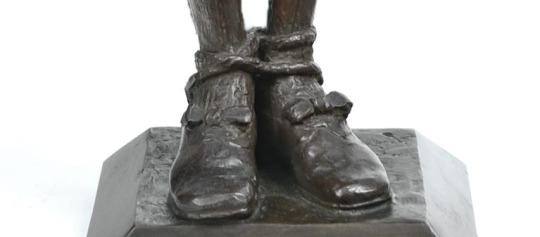
(Pratt)
on the topic of Hale statues, what really fucks me up is that the MacMonnies rendition of Nathan Hale is. it's a hot statue. the posing suggests something almost provocative (in combination with the open collar of the shirt), but only because his arms have been tied behind him in a way that forces the position, so it turns vulnerable and voyeuristic. horrifying and delightful. I'm obsessed with it.

bsky ⭐ pixiv ⭐ pillowfort ⭐ cohost ⭐ cara ⭐ ko-fi
#amrev tag#god all i did when i lived in greater boston was go to historical reenactment sites on the weekends#if i hadn't moved because the cost of living was batshit i was planning on taking history classes to qualify#to apply for one of those reenactment societies lmao#benjamin tallmadge#john andre#nathan hale
328 notes
·
View notes
Text
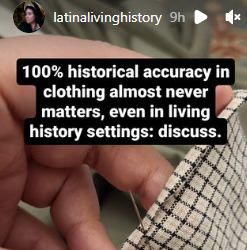
I have a lot of opinions on this but I would love to know what other people think.
#sewing#living history#historical costuming#history#historical reenactment#historical accuracy#historically accurate#historically adequate#historical sewing#museums#material culture#experimental archaeology
326 notes
·
View notes
Text

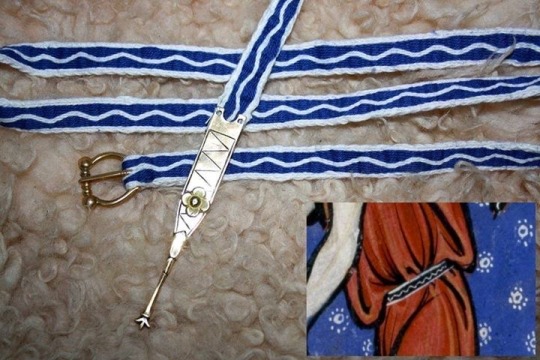
13th century tablet woven belt
#15th century#13th century#medieval#tablet weaving#loom weaving#belt#christianity#reenactment#living history#medieval clothing#reenactor#manuscript
201 notes
·
View notes
Text
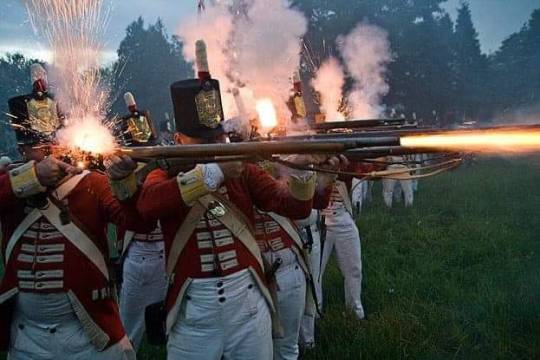
Canadian Regiment of Fencible Infantry historical re-enactment group at a Battle of Crysler's Farm event.
#war of 1812#redcoats#canadian history#dressed to kill#living history#flintlock#black powder#historical reenactment#battle of crysler's farm#crysler's farm#god i wish that were me
47 notes
·
View notes
Text
Adventures in Plant Dyeing: Part 3 - Madder
I recently bought 100g of chopped madder root and a small amount of ferrous sulphate to use as a dye modifier and so I decided to give it a go.
Madder is a plant whose roots contains a wonderful red pigment. It grows wild in England but is native to the Eastern Mediterranean. Ferrous sulphate is a modifier that can be used after dyeing to change the colour of the yarn. It tends to darken the colour and make it duller.


First I mordanted 3 50g skeins of white yarn using alum. Then I prepared the madder dye bath by soaking the madder roots in cold water for an hour before gradually heating it up to about 75°C. Apparently you mustn't let the madder boil because then it will only produce browns. Then I strained it and added 2 of my skeins to the dye bath. I was pleased to discover that the madder had quite a pleasant earthy, nutty smell, which was definitely better than boiling grass.
The so-called 'first dip' in the dye bath produces vibrant reds, which would have gone to the more high-status members of society. However after the first dip more fibre would be added and this would turn out a paler colour which would have been used for the poor. This would have continued until the dye bath was completely exhausted. I wanted to test this out and so kept back 1 skein to add later.
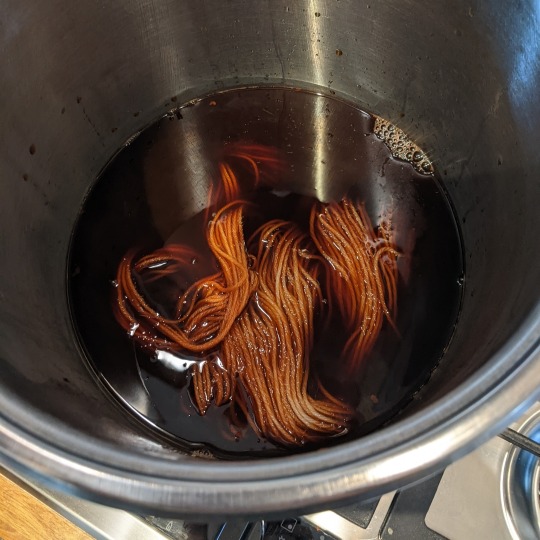
After an hour and a half, I removed the wool from the madder and rinsed it, then I added the final skein and continued to simmer it. Next I prepared the iron modifier for 1 of the skeins. I added a pinch of the ferrous sulphate (wearing gloves) to a saucepan of water and heated it until it dissolved. Then I added the yarn and left it for about half an hour, at which point I removed both the modified yarn and the second dip yarn in the madder. The modified yarn had turned an amazing dark purple, whilst the second dip yarn was a pale orange. I rinsed both out, whilst wearing gloves, and left them to dry.
Here are the results: From left to right, madder with iron modifier, 1st dip madder, 2nd dip madder.
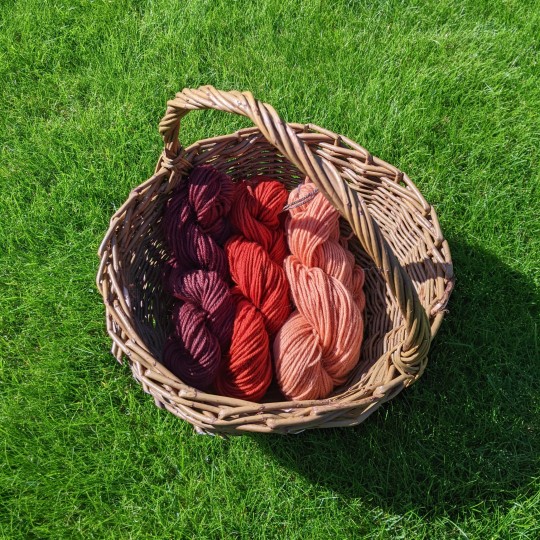
I was very surprised by how vibrant the red turned out, and how deep the iron turned the yarn just using a small pinch of iron.
I plan to dye with dried homegrown coreopsis flowers next.
#plant dyeing#living history#experimental archaeology#plant dyes#madder#reenactment#dyeing#fibre arts
94 notes
·
View notes
Text
Hey y'all apologies for ignoring this blog for so long, just got super busy! Anyways, here's my pattern instructions for making your own Guddal tunic!
Available for FREE on my Patreon
#garb ref#medieval#viking#viking reenactment#medieval reenactment#historical reenactment#historical costuming#costuming#larp#live action roleplay#cosplay#vikings#viking culture#viking history#viking age#norse#11th century#sca#society of creative anachronism#society for creative anachronism#reenactment#fashion history#sewing#patterning#sewing pattern
22 notes
·
View notes
Text
a bit of fighting i did at a small games convention two weeks back
i’m in the polished 3/4s armour with the blue trunkhose
#fantasy#medieval#16th century#historical european martial arts#hema#armour#harnischfechten#longsword#pollaxe#event#reenactment#living history#larp
13 notes
·
View notes
Note
hi! i'm sure you've answered questions like this before, but do you have any tips on how to get into living history / reenacting? i'm super fascinated by it and would love to work in/with it!! also i think you're super cool and i hope you have a great day
If you're trying to do it as a hobby, then the first thing to do is figure out what period and type of portrayal you want to focus on (civilian? military? etc.). Then look around and see if you can find perhaps a local unit. Not that it's impossible to join a unit that's further away or spread out. Most units have facebook pages etc. and you can search for them and will get related pages. Alternatively, if you find out there will be an event - especially a big event - perhaps go as a spectator and talk to the various people and units there and see if they're accepting members, try to get a vibe for what they're like etc. There are also the "umbrella" organizations that units subscribe to, who put on big events, and that can help direct you to events and units as well.
For a career, you'd be surprised at the wide variety of backgrounds that bring people to it. Obviously some people have the pure history background, but some have more of a performance background (and not only those who do "first person" portrayals, i.e. in character), some come with more of a communications/language background because of course communication is the main component of what we do. Etc. Look at various historic sites that have living history programs and apply for jobs. Or if you're able to, you can even possibly volunteer or get internships (ideally paid) to get experience. There are also a lot of seasonal museums that may be easier to get a start in, which both gives you experience as well as builds your skills and helps you determine if it's something you're interested in making a full time career. My first museum was seasonal, and I worked there for four summers (really it was half the year, but still) before getting my year round job at my current museum (which I then left to go to another museum, but eventually came back).
If you have any more specific questions please feel free to let me know, and you're welcome to message me privately as well, though of course feel free to maintain your anonymity!
22 notes
·
View notes
Text
National Museum Dublin
Hibero-Norse glass beads, dated around 800 - 1100 C.E. Dublin.

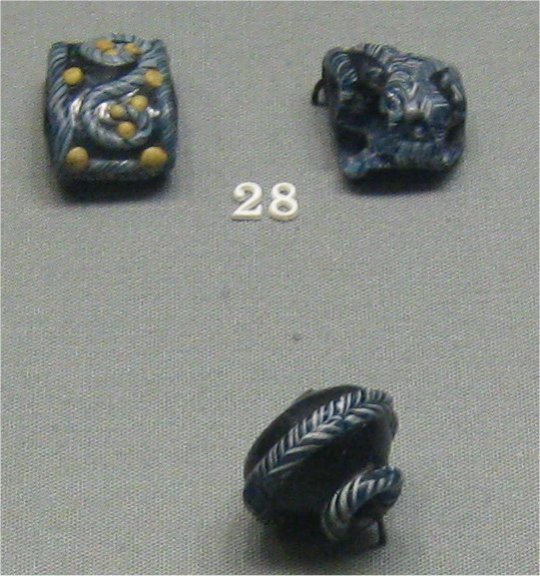
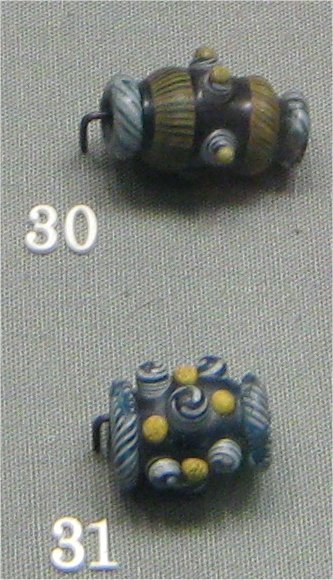
Oval brooches and glass beads. (Dublin, Island Bridge)
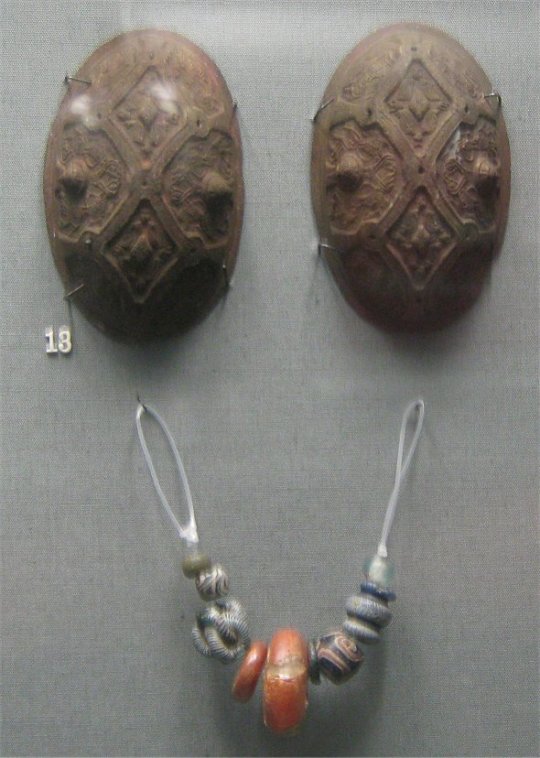
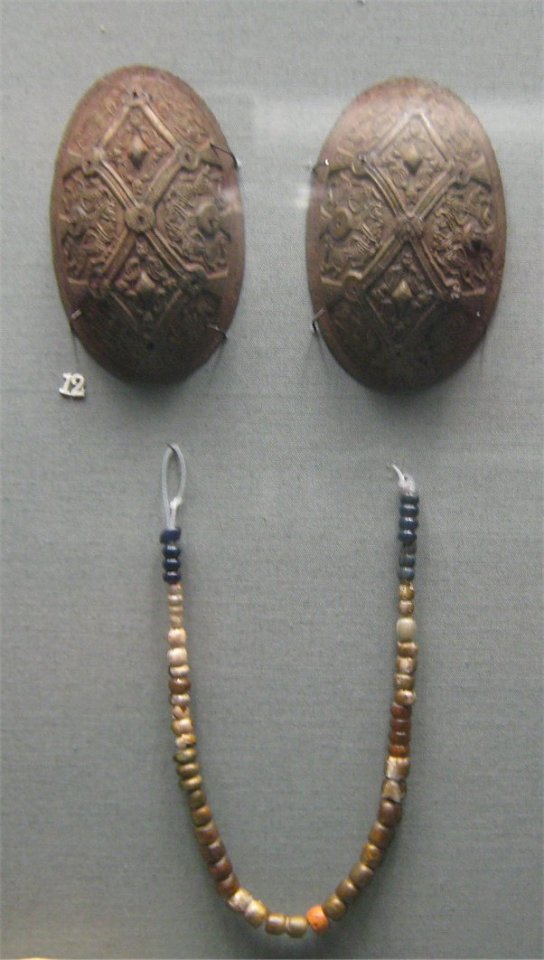

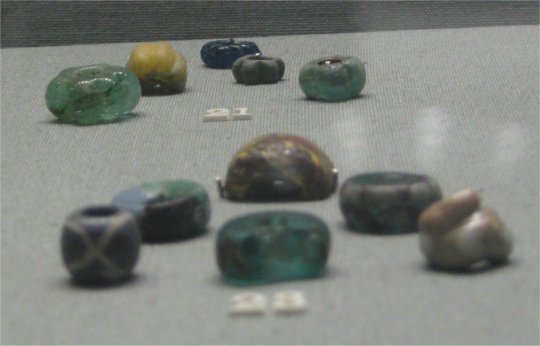
18 notes
·
View notes
Text
#reenactment#living history#historian#historical reenactment#reenacting#living history reenactment#living history museum#war reenactor#sca#the sca#the society of creative anachronism
4 notes
·
View notes
Text

Please help, I've know this show for only a few hours and it's rapidly becoming my first hyperfixation of the new year
#puppet history#my sister just sent me a video of a psychopathic holographic muppets singing about reenacting silence of the lambs#that was like 5 hours ago now and I've watched 5 episodes of it and listened to that damn song 5 times as well#this things gonna live rent free in my head for a while and I'm gonna enjoy the time it spends in it#memes i made#the substitute
90 notes
·
View notes
Text
A visit to The Grand Hotel on Mackinac Island, Michigan. Gowns circa 1911, photos circa 2008.


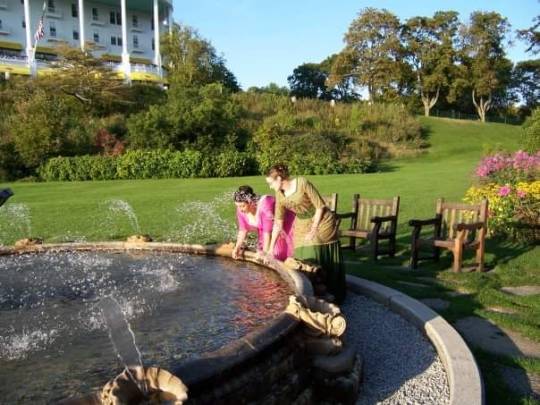



Based on gowns in the Kyoto Costume Institute, seen here:
#living history#historical costuming#history#historical reenactment#michigan#the grand hotel#mackinac island#michigan history#edwardian#edwardian fashion
51 notes
·
View notes
Text

And to that, I hold. I would rather share one lifetime with you than face all the ages of this world alone.
(Original photo from medieval festival in Belgrade, Serbia - ig: @sarcasmaddict_ @_witch_king_of_angmar )
#15th century#living history#medieval#reenactment#reenactor#medieval clothing#medieval knight#fantasy#photoshoot#photo edit#princesscore#medieval fashion#medievil#medien#poppy and casteel#medieval painting#medieval period#medieval poetry#medieval peasant#medieval dress#tailoring#sewing#embroidery#fabric#instatumblr#instalike#instagram#aesthetic#lord of the rings
118 notes
·
View notes
Text


Reenactors of the Old Northwest Military History Association portraying Cushing’s Company of the 2nd US Artillery in the War of 1812 at Fort Meigs, Ohio.
#war of 1812#historical reenactment#military history#united states army#artillery#napoleonic#1810s#dressed to kill#living history#fort meigs#ohio#sorry i am going a little crazy about fort meigs in light of recent events#obsessed
82 notes
·
View notes
Photo

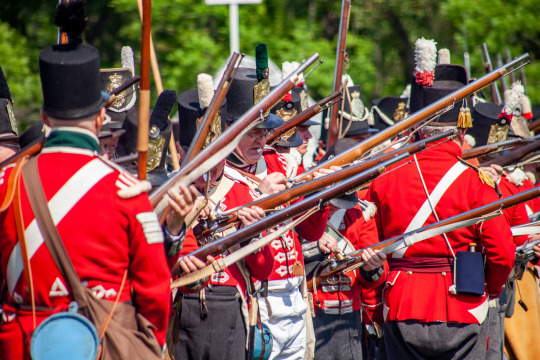



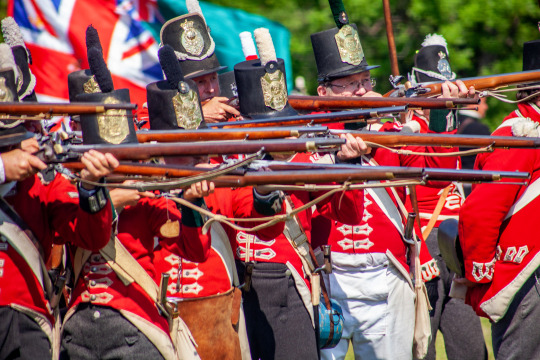
It was also a lot of fun to make it out to the Battle of Stoney Creek war of 1812 reenactment. I’d wanted to get out to an 1812 event to take photos and this was great. Unfortuantely I only had a couple of hours to stick around. I’d like to get more opportunity to shoot a full event, especially the camp life, women, kids, officers - the stuff you don’t see the details of during the battles.
#reenactment#reenactor#reenacting#living history#49th regiment#41st regiment#imuc#stoney creek#battle of stoney creek#history channel#war of 1812#1812#musket#uniform#shako#redcoat#redcoats
34 notes
·
View notes